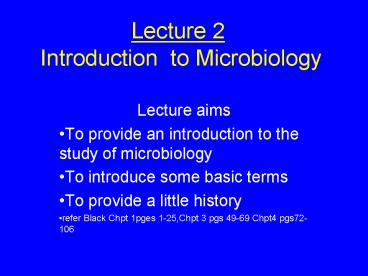Lecture 2 Introduction to Microbiology - PowerPoint PPT Presentation
1 / 18
Title:
Lecture 2 Introduction to Microbiology
Description:
Let's leave it to the Path lab to deal with! ... LOUIS PASTEUR: Demonstrated by the use of sterile media that microbes were in fact ... – PowerPoint PPT presentation
Number of Views:162
Avg rating:3.0/5.0
Title: Lecture 2 Introduction to Microbiology
1
Lecture 2 Introduction to Microbiology
- Lecture aims
- To provide an introduction to the study of
microbiology - To introduce some basic terms
- To provide a little history
- refer Black Chpt 1pges 1-25,Chpt 3 pgs 49-69
Chpt4 pgs72-106
2
The Nature of Microbiology
- Microbiology has a wide range of applications
- We will focus on
- The kind of microbes
- How they are related to disease
- Infection control
3
Why Bother with Microbiology?Lets leave it to
the Path lab to deal with!
4
Perhaps the following case study will assist us
in our decision as to the relevance of
microbiology to the practicing health
professional
- You're the registered nurse in an intensive care
unit (ICU) with 3 - febrile patients and 1 developing a wound
infection - Relevant (immediate) patient histories
- Patient No. 1 adult female following abdominal
surgery - Patient No. 2 adult male from oncology following
chemoX - Patient No. 3 child with community acquired
pneumonia - Patient No. 4 adult male develops lower limb
surgical wound infection - A new intern asks what will I do
microbiologically, nurse? - Can you assist her?... if you can't, you need to
do some - microbiology
5
Possible short answers to case studies
- Patient 1 with abdominal surgery Take blood
cultures and - empirically X with amoxyl, gentamicin and
metronidizole. - Patient 2 take blood cultures depending how
seriously ill, treat - with as above or if life threatening,
consider imipenem /- - vancomycin.
- Patient 3 take sputum sample and blood cultures
and treat - empirically with cefotaxime.
- Patient 4 take swabs of wound for microbiology
analysis, - consider blood cultures. If wound is below
knee consider empirical - treatment with flucloxacillin amoxil
keep in mind possibility of - MRSA and therefore vancomycin.
- Rationale The 67421 microbiology course
6
Microbiology defined
- The study of organisms, where the individual
cells of the - 'microbe' can't be seen by the unaided
human eye' - That is, we need to use specialized detection
systems-usually - optical instruments termed microscopes.
- There are 2 main type main types of microscopes
in use - Bright field microscope resolution about 0.2µm
- Electron microscope resolution about 100 times
greater
7
The microbial world2 divisions Procaryotes
Eucaryotes
- Procaryotes
- No nucleus
- Generally circular DNA genome
- /- cell wall
- Can have extrasomal DNA
- DNA without introns
- Haploid
- Binary division
8
- Eucaryotes
- Have nucleus
- Other membrane organelles
- Diploid chromosomes
- Mitotic meiotic division
- Have introns and exons
9
In clinical microbiology we have interest in both
- Bacteria (procaryotic)
- Eg Staph sp, Strep sp, E.coli, Mycoplasma sp
- Fungi (eucaryotic)
- Candida sp (single celled yeast), Aspergillus sp
(multicelled) - Parasites (eucaryotic)
- Giardia lamblia, Plasmodium sp (malaria)
- Viruses
- HIV, HBV, HBC, Rubella, Herpes (EBV, VZ, HSV)
10
Microbial classification
- Two components
- Nomenclature (Taxonomy)
- Use as many characteristics as possible to
separate Kingdoms, Families, Genera and Species - Rapid identification (clinical use)
- Use as few definitive characteristics to define
the agent to assist appropriate intervention
11
Example of a diagnostic key
- Unknown bacteria 'X'
- Gram stain ( /-)
- Shape (eg cocci, rods, coccobacilli) c
- Configuration (chains, clusters,
diplo) clusters - Catalase(/-)
- Coagulase (/ -)
- Antibiotic sensitivity (eg Methicillin S/R)
R - Identification Multi Resistant Staphylococcus
aureus (MRSA)
12
A little History
- Main events people (refer table 1.3 pge 21 in
text) - Before about 1650 philosophers believed in
SPONTANEOUS - GENERATION
- Significant discoveries altered this thinking.
13
Some of the key players were
- ANTON van LEEUWENHOEK
- Mid 17th Century probably 1st to observe bacteria
under - magnification
- Although Robert Hooke first to observe microbes
through magnification)- Its thought he saw
protozoa ie larger cells such as amoebae)
14
- LOUIS PASTEUR
- Demonstrated by the use of sterile media that
microbes were in fact - present in air,
- And that air in does not create microbes
- Used broths in flasks and S funneled microbial
traps experiments
15
- Ignaz SEMMELWEIS
- Discovered that the death rate of neonates in
labour wards staffed - by trainee doctors was 10-20 higher than in
hospitals training only - midwives
- Joseph LISTER
- adopted the use of 'aseptic' techniques which
lead to its general adoption)
16
- ROBERT KOCH
- Proved beyond doubt that specific organisms were
the cause of specific infectious diseases. - Experiments with the very lethal disease
(especially of cattle) - anthrax
17
- KOCHS POSTULATES
- 1. The same 'pathogen' must be present in every
case of the - disease
- 2. The pathogen must be isolated from the
diseased host and - grown in pure culture
- 3. The pathogen when inoculated into a
susceptible uninfected - host causes the disease
- 4. The pathogen must be reisolated in pure
culture from the - inoculated animal
18
(No Transcript)































